For a long time, the transmission and drive webpage on the kartbuilding.net website has been lying idle, and unfinished. This article covers one of the unfinished articles, “One single gear, using a centrifugal clutch, and chain drive.”.
About Centrifugal Clutches
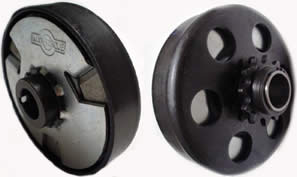 The Centrifugal clutch is one of the most popular and simple methods of transmitting power from the engine to the rear wheels in a go-kart/go-cart. This type of clutch is fully automatic, and works depending on the speed (revs) of the engine. If the engine is turning over very slowly, then the centrifugal clutch is disengaged, and the kart comes to a stop. If the engine speeds up (increase Revs Per Minute rpm) then the automatic clutch will engage, and the kart will move forward.
The Centrifugal clutch is one of the most popular and simple methods of transmitting power from the engine to the rear wheels in a go-kart/go-cart. This type of clutch is fully automatic, and works depending on the speed (revs) of the engine. If the engine is turning over very slowly, then the centrifugal clutch is disengaged, and the kart comes to a stop. If the engine speeds up (increase Revs Per Minute rpm) then the automatic clutch will engage, and the kart will move forward.
There are two parts/components to every Centrifugal Clutch:
- Bell Housing & Sprocket
This bell housing, with its small sprocket connected to the rear axle via a drive chain, spins freely on the engine‘s output shaft, and as a result will need some grease and oil to keep it in good running order. With the engine turned off, the kart can be pushed forward, driving the chain, and spinning the bell housing freely. - Center Shaft with Weighted Friction Shoes
This Center Shaft/Unit is directly attached to the engine‘s output shaft. It is attached to the output shaft via a “keyway” and “grub screw” as will be discussed in the Fitting section in this article. Once the engine speeds up, this Center Shaft will expand and grip the bell housing, and in turn drive the chain.
These types of clutches can get very technical, in terms of power and speed ratings. There are numerous types of clutches available, with various “inner bore diameters”, “horsepower ratings”, “RPM engage\disengagement ratings”, “sprocket & chain sizes”. It is advisable to find out the essential information for your engine, if you are going to buy one of these centrifugal clutches. The small sprocket which comes attached to the “Bell Housing” needs to match the pitch and width of your large rear sprocket on the rear axle of the go-kart.
Buying/Sourcing a Centrifugal Clutch for a Go-Kart/Cart
The best places to get/buy these types of clutches are: your local karting arena, ebay, www.northerntool.com, www.cometkartsales.com. Don’t go and buy the first Centrifugal clutch you see. Shop around for a cheap quote. Also – try and get a typical and well known clutch (especially of you are buying a brand new one), as the “friction shoes” tend to wear quite quickly depending on your gear ratio. Comet type centrifugal clutches are the most well known brand.
Fitting a Centrifugal Clutch for a Go-Kart
Once you have obtained a suitable Centrifugal clutch, and depending on whether it has the correct “inner bore diameter”, fitting will be relatively straight forward. As mentioned earlier, there are 2 pieces/components to the Centrifugal Clutch: the Bell Housing, and the Center Shaft.
The bell housing goes onto the engine shaft first, with its concave bell housing facing outwards. This bell housing spins freely on the engine’s shaft, so make sure to put some grease between the inner bore diameter of the housing and the outer diameter of the engine shaft. Push the bell housing in on the engine shaft as far as possible (until it hits the flange on the engine).

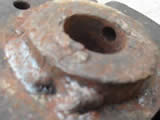
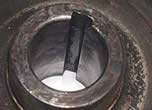 The Center Shaft with its Friction shoes is placed onto the engine next. There should be a “keyway” cut into the inner diameter of the clutch shaft which should align with a keyway in the engine’s shaft. This keyway makes sure that the “Center Shaft” will rotate with the engine. To stop the “Center Shaft” from slipping out off the engine shaft, there is a hole to allow a “grubscrew”. A grubscrew is where a threaded small bolt will screw through the Center shaft and tighten in on the engine shaft. You may or may not receive the rectangular metal “key” with the centrifugal clutch or not. I suggest you visit a lawnmower repair shop or a hardware store to obtain a suitable “key”. Below is a photo of the Centrifugal clutch transmission complete. A plastic chain guard can also be seen. If your engine does not have a keyway, and perhaps has another PTO (power take off) Shaft Type(s) as can be seen here, then you may have to resort to welding the “Center Shaft” to the engine’s output shaft. This should only be done as a last resort.
The Center Shaft with its Friction shoes is placed onto the engine next. There should be a “keyway” cut into the inner diameter of the clutch shaft which should align with a keyway in the engine’s shaft. This keyway makes sure that the “Center Shaft” will rotate with the engine. To stop the “Center Shaft” from slipping out off the engine shaft, there is a hole to allow a “grubscrew”. A grubscrew is where a threaded small bolt will screw through the Center shaft and tighten in on the engine shaft. You may or may not receive the rectangular metal “key” with the centrifugal clutch or not. I suggest you visit a lawnmower repair shop or a hardware store to obtain a suitable “key”. Below is a photo of the Centrifugal clutch transmission complete. A plastic chain guard can also be seen. If your engine does not have a keyway, and perhaps has another PTO (power take off) Shaft Type(s) as can be seen here, then you may have to resort to welding the “Center Shaft” to the engine’s output shaft. This should only be done as a last resort.

Typical Gear Ratio and Chain Drive Setup
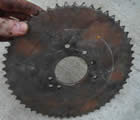 On Centrifugal Clutches, the small sprocket attached to the “Bell Housing” has typically 10 teeth (although this can vary). As a rough estimate, a gear ratio of 5:1 is needed for a standard/typical go-kart/cart, with a 5hp engine running at 3500 rpm, and with rear wheels of diameter 300mm or 12inches. The speed of the go-kart can be calculated based on this “gear ratio” combined with rpm of the engine and diameter of the rear wheels (Calculate speed of go-kart). A large sprocket with 50 teeth for the rear axle can be difficult to obtain. Ask for this large sprocket at the time you are buying the centrifugal clutch and it will save a lot of looking.
On Centrifugal Clutches, the small sprocket attached to the “Bell Housing” has typically 10 teeth (although this can vary). As a rough estimate, a gear ratio of 5:1 is needed for a standard/typical go-kart/cart, with a 5hp engine running at 3500 rpm, and with rear wheels of diameter 300mm or 12inches. The speed of the go-kart can be calculated based on this “gear ratio” combined with rpm of the engine and diameter of the rear wheels (Calculate speed of go-kart). A large sprocket with 50 teeth for the rear axle can be difficult to obtain. Ask for this large sprocket at the time you are buying the centrifugal clutch and it will save a lot of looking.
Centrifugal Clutch from a Chainsaw
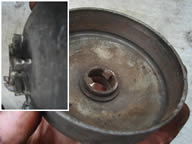 Instead of buying a purpose go-kart centrifugal clutch, it is also possible to get similar centrifugal clutches in “chainsaw engines” and “mopeds/scooters”. Although these types of clutches were not designed specifically for a go-kart it is possible to adapt these to suit a different engine. As can be seen in the photo on the left, a smaller “inner bore diameter” will be found in clutches from chainsaw engines. Also, instead of a small drive sprocket attached, there will be a special star shaped sprocket, which typically drives a cutting chain. A small drive sprocket will instead have to be welded to the “Bell Housing”.
Instead of buying a purpose go-kart centrifugal clutch, it is also possible to get similar centrifugal clutches in “chainsaw engines” and “mopeds/scooters”. Although these types of clutches were not designed specifically for a go-kart it is possible to adapt these to suit a different engine. As can be seen in the photo on the left, a smaller “inner bore diameter” will be found in clutches from chainsaw engines. Also, instead of a small drive sprocket attached, there will be a special star shaped sprocket, which typically drives a cutting chain. A small drive sprocket will instead have to be welded to the “Bell Housing”.
Centrifugal Clutch from a Moped/Scooter
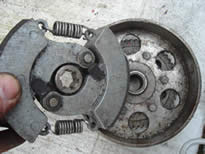 Inside mopeds/scooters there are also centrifugal clutches, however these are slightly different in the fact that they are “wet clutches”, where the “Bell Housing” and “Weighted Center Shaft” run in an oil bath! It might seem impossible at first that a clutch can run in oil, however the oil keeps the clutch cool and free from maintenance. Again similar to the chainsaw type centrifugal clutch, there will have to be adaptations done, as there will be a “Splined” inner bore which will need to be drilled out to suit the engine’s output shaft.
Inside mopeds/scooters there are also centrifugal clutches, however these are slightly different in the fact that they are “wet clutches”, where the “Bell Housing” and “Weighted Center Shaft” run in an oil bath! It might seem impossible at first that a clutch can run in oil, however the oil keeps the clutch cool and free from maintenance. Again similar to the chainsaw type centrifugal clutch, there will have to be adaptations done, as there will be a “Splined” inner bore which will need to be drilled out to suit the engine’s output shaft.
In some mopeds/scooters there are 2 centrifugal clutches each which engages at different rpm of the engine. Therefore when the scooter is going slow and the engine is slow, the first centrifugal clutch engages. This provides a high gear ratio giving extra torque at low speeds. When the moped is moving at an average speed, and the engine turns faster, the second centrifugal clutch with a lower gear ratio kicks in and changes the gear ratio. This setup is very complicated involving a ratchet type free wheel system and is not feasible for use on a kart. It is possible to adapt and use one of these clutches however on a kart.
Conclusion to Centrifugal Clutches, Chain Drive and a Single Gear Transmission for a Go-kart
Having a clutch in a kart allows for great freedom, where the engine can be started and the kart can remain stationary. It also allows the driver to stop the kart without having to turn off the engine. Depending on the weight of the kart, the speed and power of the engine, a centrifugal clutch may not be ideal, but it will work. It is the most effective and simple Single Gear Transmission for a Go-kart. It is referred to as a “Single Gear Transmission” because there is only 1 speed and 1 gear ratio that the kart can go at. As a result of there been only 1 gear ratio, there has to be a hard line drawn between fast take off speed and high end speed.
If you have any comments or queries on this article, feel free to contact the author at: kartbuilding [at] gmail.com
I’m looking to change my karts drive train from a belt to a chain. The kart currently has a comet 20 series centrifugal clutch, with a lay shaft then going to the wheels with a chain. The specs are:
18″ wheels
Honda gx360 engine
12.6 hp
3000rpm
Teeth on lay shaft 12
Teeth on axle 52
Would I be able to leave out the lay shaft and put a direct drive from the clutch to the axle with a chain centrifugal clutch? What would be the best way to do this? Finding it very hard to get an answer! Hope you can help!
@Miles:
You should be able to put a direct drive in place – using a centrifugal clutch on the engine, and connect a chain from there to the rear axle.
How many teeth are on the centrifugal clutch on the engine – 12 teeth? If you have 12 teeth on the engine and 52 on the rear axle, you have a Gear Ratio of 4.33 : 1
So for every 4.33 revolutions of the engine shaft, the rear axle will do 1.
You have 18″ diameter rear wheels? – These are VERY big.
I don’t know if you will have a sufficient gear ratio and the clutch may slip and burn on take-off. It depends on the type and size of centrifugal clutch and if it will take the full 12.6hp.
My suggestion is to give it a go and see. If you could get a rear axle sprocket of 60teeth, then that would give a nicer 5:1 ratio.
Best of luck with it. — Steve
ok i have a honda 9hp go kart and i bought an 17 tooth clutch and my rear axle sprocket has 60 teeth and my go kart will not move at all and so i put some grease on the inside hole on th clutch and the bar that holds the clutch and now it slides easy and i dont know what to do about a screw because if put one on it will not even hold the clutch because the hole is to big
@rj:
17 teeth on the clutch/engine and 60 teeth on the rear axle gives you a gear ratio of 3.5 : 1. This is a very low gear ratio.
Typically you would want 5 : 1 otherwise there would not be enough torque to move the kart! This is what I think may be happening your kart. When you speed up the engine, it tries to spin the clutch housing, but can’t move the kart forward. Perhaps if you got someone to push the kart, and then speed up the engine, it may take off.
Regarding the screw and the clutch hole too big. Is the inside part of the clutch wobbling on the engine drive shaft? ( http://www.kartbuilding.net/gallery/v/Kart_Clearance_and_Memories/DSC01111.JPG.html ) There should also be a keyway that drives this inside part of the clutch. If all this is too loose, the engine drive shaft may be turning, but not turning the inside part of the clutch. This is not easy to fix. Typically when you get clutches you give the size of the engine shaft.
If you want to email some photos of the clutch, your engine and rear axle to kartbuilding@gmail.com I can advise better.
hi i was wondering if the clutch you are using has a groove for a keyway do you need to use one
I’m making a go cart out of a 12hp Kohler riding lawnmower. The engine is a vertical shaft engine. Can I use this method of power and if so how do I connect it
hey I just got this 16hp go kart for 240$ and on top of that I got a Hilliard clutch . and it’s all put on and everything but the clutch will start to smoke and heat up really bad after 10min of use. I’m just not sure why it keeps on smoking and heating up so fast. could you help me out
@esteban:
It sounds like the gear ratio is wrong. The gear ratio is:
size of the sprocket on the clutch : size of the sprocket on the rear axle.
You may need to use a smaller sprocket on the clutch. You can get small sprockets for the clutch – I had 10 teeth on mine.
Or, you can try and get a larger sprocket for the rear axle. The sprocket on the rear axle would need to be 5 or 6 times the size of the sprocket on the engine clutch.
Yes, the clutches I used had a keyway and luckily managed to fit perfectly onto the engine.
On one occasion however I had an engine with no keyway. I managed to weld the clutch to the outside of the engine shaft (allowing me to grind off the weld, should I need to remove the clutch in future). I wouldn’t recommend this method however and it would have to be a last resort.
Recently purchased a used Honda GX160 from a snowblower. Has an S type shaft,(metric) that is about .789 so the 3/4 centrifugal clutch won’t work. Does anyone make a metric bore clutch? or do I need to get the 3/4 machined to the correct bore. Also the key width appears different so I will probably need to machine a step-down? or do I need to change the shaft?
It should be very possible to get a metric centrifugal clutch. It would be way easier than modifying an imperial one what with the keyway and all. If you contact any suppliers of centrifugal clutches they will be able to help you.
I’ve got a machine at home that I’ve built and the engine Im running is a 9hp honda with a 1 inch shaft. So I’ve got a centrifugal clutch on that, that has 17 teeth, the rear sprocket has 52 teeth. The chain I’m using has a 3/8 pitch. My problem is that the chain fits around the sprockets fine but it seems to grab only half or so of the teeth and not lock Into the rest. Does anyone know what’s going on? Both sprockets and chain are new. May be a stupid question but I can’t find a way to fix it.
Hi I am thinking of taking a Yamaha zuma X50 scooter that has a automatic dry centrifugal clutch and a CVT as common on these scooters. I want to cut off and remove the CVT transmission and put up a conventional GoKart centrifugal clutch on the drive shaft of the engine. Is this possible? I am doing this for the Shell Eco Marathon project. Your early reply is highly appreciated.
Hey I have a 2 seater murry gokart that I took the 5hp off and put a 9hp honda pressure washer engine on it. It has a 1 inche bore shaft and I put a hillard 14 tooth clutch on it I’m running a 60 tooth sprocket on the wheel my problem is it dosent move vey well it hardly takes off then the clutch gets hot I hope u can help
Hi I have a 9hp Honda motor I took off. Pressure washer and put on a 2seater go kart it has 1 inch shaft so had some the clutch I went with is a hillard 14 tooth, I have a 60 tooth drive sprocket it is single wheel pull also running a #40 chain. The problem I am having is when we try to take off in it it moves very slow on flat ground then once you start to go up a small incline it stops and the clutch gets hot. Hope you can help
I have a carter with a 12 teeth clutch a jack shaft with 12 in and 10 out to a 60 sprocket the clutch 18in rear wheel the gear ratio is 6 to 1 the clutch justs smokes it’s like the clutch wants to engage but just slips any ideals
I just purchased a 346cc-(11hp) I want to make a my bike to have more torque.Then top end speed which do you suggest?
Hello. I have just recently bought a go kart that has a new 11hp motor on it. The torque convertor on the motor I believe was only rated for 8hp and chewed the belt like nothing. So I just bought a Hillard clutch that is rated for 13hp and has 17 teeth. My tires are 22 inch. Now I just ordered a 85 tooth axel sprocket to give me a 5:1 ratio. My only concern is that the Hillard clutch has a #35 chain, so will the new sprocket. Do you think that #35 chain is good enough. I weigh 250lb and I know the go kart is about that much in weight.
Hi all I have a 200cc go kart I won’t it to go up hills not speed just go up hills what tooth do I need I have 10 on clutch an 48 or rear an no good help please
@Steve: 10 tooth on clutch and 48 on rear gives a gear ratio of 4.8:1
This wouldn’t be suited to going up hills. You would want a ratio of 6:1 or greater.
It also depends on how big your rear wheels are. If you have big rear wheels – then you need a bigger ratio.
I suggest you try and get a larger sprocket for your rear axle.
You could also try and setup a “transfer axle”, where you use a “middle shaft” and use two chains in order to get a good ratio.
See: http://kartbuilding.net/gallery/v/OtherPeoplesKarts/OscarForand/P1010103.JPG.html
@Jason: well If the Hillard clutch with #35 sprocket is rated for 13hp, then it should be ok. I’ve rarely seen chains break on tensile strength. It may wear the sprocket teeth quite quick. Let us know how it goes for you.